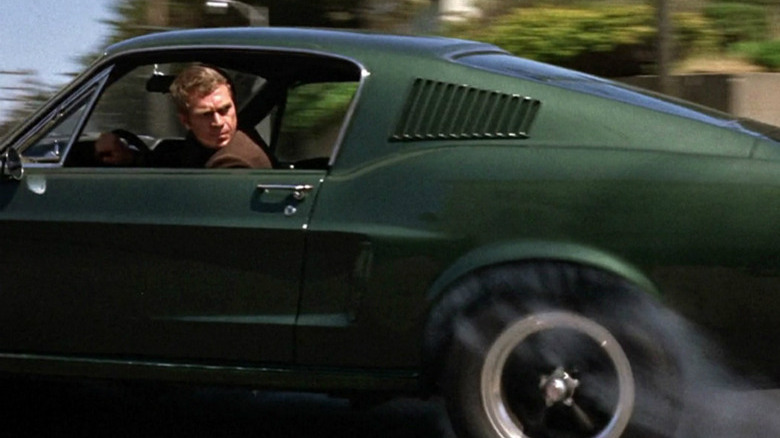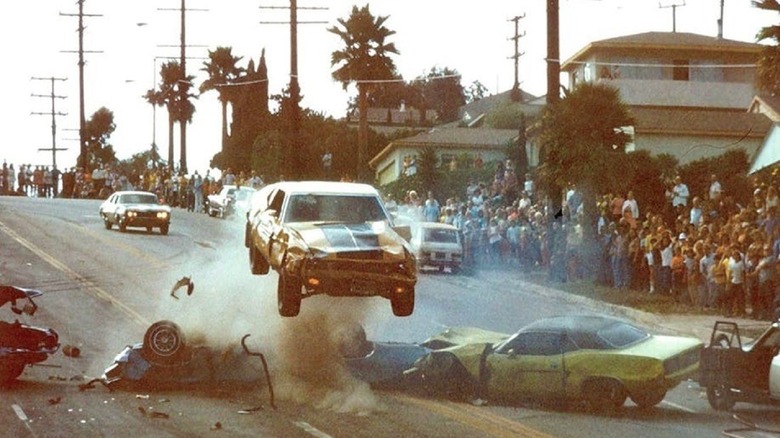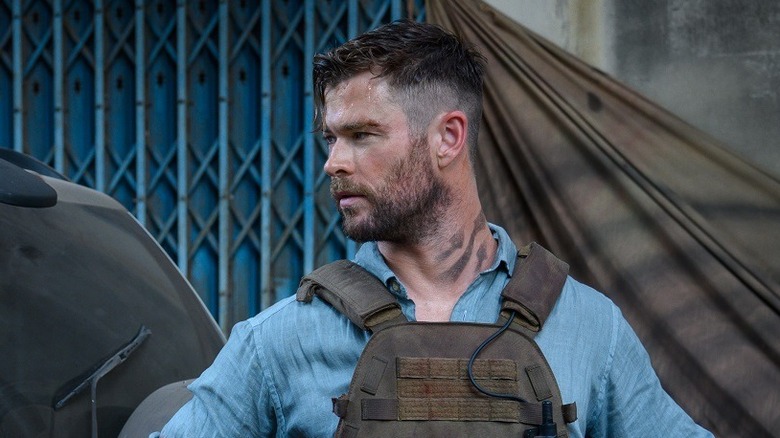How Car Chase Scenes Are Becoming More Extreme
This content was paid for by Netflix and created by Looper.
Hollywood has come a long way since the first cinematic car chase was committed to celluloid back in 1903's "Runaway Match." In that film, someone simply strolling along at a brisk pace might've been able to catch up with the old-school wheels in motion, but nowadays, there are no limits to the speed, locations, or even volumes of vehicles that can be involved in a good chase scene.
And over the last few decades, the intensity of movie road races has increased exponentially, and it's not just about how revved-up the sequences can look due to computer-generated imagery and daring stunt work. Modern movies have also found new ways for their roadway action scenes to stand apart from the crowd through clever character focus, very cool camera angles, and other innovations in filmmaking.
"Gunpowder Milkshake" is the latest example of an action film that puts pedal to the metal with a slick car chase, and it really gets audiences into gear for some fun. In the film, young hitwoman Sam (Karen Gillan) decides to turn her back on her ruthless employers at the mysterious Firm in order to protect Emily (Chloe Coleman), an innocent 8-year-old girl who's caught in the crosshairs during Sam's latest assignment. But after Sam's colleagues are sent after her and render her arms useless with a paralytic agent, she has to rely on Emily to take the wheel of their getaway car, just as other enemies begin closing in on them. With Sam giving her instructions, Emily gets something of a crash course for her first driving lesson since it's up to her to make all the sharp turns and shifts — sometimes even with her eyes closed so she won't see the ensuing carnage. Not only is the scene electric and highly entertaining, but it's also a surprisingly touching team-building moment for Emily and her newfound guardian.
By topping off this high-octane action setup with a few unique twists and some clutch narrative moves, "Gunpowder Milkshake" proves that a good car chase scene can be about so much more than fast wheels and wreckage. So to celebrate this creative take on the action tradition, here's a look back at how car chase scenes have become so much more extreme over the years.
First gear
Though car chase scenes certainly existed in movies before the late '60s, the blueprint for many modern movie chases can be found in one of the most enduring films of the decade: 1968's "Bullitt." The movie featured the one and only Steve McQueen as Lt. Frank Bullitt, burning rubber in his now-iconic green Mustang GT while whipping and weaving through the busy streets of San Francisco to escape and then chase a pair of hitmen. The 10-minute action sequence is widely regarded as one of the most influential ever, thanks in no small part to its revolutionary array of camera angles that gave audiences multiple vantage points, including some critical point-of-view shots of the driver and the vibrant city that played unwitting host to the speedy skirmish. Not only did the sequence steadily accelerate from some quaint traffic sign-abiding evasive maneuvering into an explosive collision, but the crafty construction, styling, and editing of the scene made a lasting impression on Tinseltown and increased what was possible for cinema's car chase sequences.
The very next year, in 1969, the British comedy caper "The Italian Job" introduced yet another of the most memorable chase sequences of all time. The film featured Michael Caine as a criminal ringleader who decided to manipulate the traffic control system in Turin to allow his team to escape in their envoy of Mini Coopers after a big gold heist. But the toy-like nature of the vehicles didn't stop the scene from being incredibly climactic. The cars raced through multiple terrains, including staircases, busy pedestrian zones, a steep building roof, rushing water, and a sewer tunnel as they ducked the pursuing police. In this case, it wasn't any sprawling damage that made the sequence stand out. Instead, it was the tight synchronization of the maneuvers and increasingly unpredictable obstacles that made the scene so satisfying to watch. The 2003 remake of course honored the original with some thrilling and creative chase sequences, including the use of those signature little vehicles bouncing through some familiar locales, but it wasn't the only film to benefit from a bit of well-choreographed driving.
Shortly thereafter came another game-changing chase scene in 1971's "The French Connection." William Friedkin's classic crime thriller, which absolutely dominated at the 44th Academy Awards, starred Gene Hackman as "Popeye" Doyle, an NYPD detective who commandeered a car to chase after a speeding elevated train that had a dangerous hitman onboard. With a range of tight shots — including the now-classic view of the street ahead from the front bumper of the vehicle — the scene was highly realistic and immersive for audiences and helped to usher in a new era of heightened expectations for car chases.
The same year, "Vanishing Point" hinged its entire plot on a high-speed journey through the arid Southwest, bringing some helicopter action into the mix for added velocity, and Steven Spielberg made a roaring directorial debut in "Duel," which turned a simple Peterbilt 281 into a terrifying weapon as its driver relentlessly harassed an unsuspecting commuter. And "French Connection" producer Phillip D'Antoni then recruited "Jaws" star Roy Scheider for a thrilling trek through the Big Apple in 1973's "The Seven-Ups," which featured even more rubber-burning mayhem across various parts of the city.
Gassing up
Soon after, car chases in movies became even more robust. It became increasingly commonplace for major car chase scenes in action flicks and comedies alike to incorporate some death-defying jumps, along with an onslaught of new car stunts, like rollovers, more severe crashes, and driving on the wrong side of the road. Many of these films also made sure to distinguish their signature vehicles with bright colors and insignias to make their journeys even more exciting and memorable.
For example, 1974's "Gone in 60 Seconds" featured a jaw-dropping 40-minute car chase that included dozens of cars being damaged or flipped along the way, all before the prized pony, "Eleanor," was thrust high into the air to fly for 128 feet over a traffic jam. The sheer length of the chase sequence might've made the movie memorable enough, but with that gravity-defying stunt, the pic was an instant all-timer. The same year, the James Bond film "The Man with the Golden Gun" pulled off an unbelievable corkscrew jump, spinning 360 degrees above water.
Then, 1977's "Smokey and the Bandit” injected some humor into its hot pursuits, like the moment when a full-on trucker caravan formed to conceal Burt Reynolds' bootlegger Bandit from the police. Of course, no discussion of the film would be complete without a mention of the impossible jump his trusty Trans Am made over a missing piece of bridge. And 1979's "Mad Max" kicked off an entire franchise of racing scenes across wild terrains, giving us moments that were gritty, highly imaginative, and violent, carrying entire storylines on the hood of that iconic Interceptor.
The 1980 classic "The Blues Brothers" saw its titular twosome, portrayed by Dan Aykroyd and John Belushi, set out "on a mission from God" to save their childhood orphanage. Along the way, the duo had to escape all manner of aggressive vehicular pursuits in the Bluesmobile, culminating in one unforgettable jump and the spectacular collision of dozens upon dozens of police cars. The film's stunts were very, very real, and over 100 vehicles were ravaged in the making of the movie, which meant, even though a lot of the story left audiences in stitches, there were also a lot of white knuckle moments in there as well. All of these films continued to take risks and stretch the limits of what a good car chase could look like in film, and they earned some primo parking spaces in the lot of Hollywood's hall of fame.
Full tilt
Over time, car chase scenes became just as elemental to action movie plots as explosions, heavy artillery, and muscle-bound heroes. And as the prevalence of car chases became more accelerated, so did the focus on increasing the styling and stakes for the characters involved.
Some of the most epic chase scenes to emerge in the '80s and '90s included the tanker attack from "The Road Warrior," the canal chase in "To Live and Die in L.A.," and the fiery plane pursuit in "License to Drive." On top of that, you've also got epic moments like the explosive T-1000 chase in "Terminator 2," the dusty desert run in "Thelma and Louise," the destructive city drive in "The Rock," and the Paris chase in "Ronin," just to name a few. Even amid an increasingly crowded field of cinematic car chases, these films managed to stand out by adding unique and often daring twists to the conventional action format.
Thanks to an increase in CGI and green screen techniques — coupled with impressive practical effects — car chases somehow became even more intense than they already were after the turn of the millennium. Franchises like "The Fast and the Furious," "The Matrix," "Mission: Impossible," "The Bourne Identity," and "John Wick” put a lot of effort into one-upping each other and themselves with exhilarating chase scenes filled with death-defying stunt work, edge-of-your-seat action, and new signature moves. Thanks to blockbusters like these, the notion of people hopping to and from moving cars and reaching impossible heights with grounded vehicles wasn't so unusual, and filmmakers started finding even more tricks to take their chase scenes to the finish line. Memorably, "Extraction" took its extended chase scene across all manner of difficult terrains and managed to pull off a roving 360-degree view of the perilous journey, with close-ups, wide shots, and every other vantage point audiences could possibly want to take in the action.
But it's not just slick styling and daring stunt coordination that's taken modern chase scenes to the next level. Many recent films have also begun to use their car chase scenes as devices for true character development while still keeping all the intensity intact. Consider how "Drive" and "Baby Driver" both feature memorable chase scenes as introductory moments for their lead characters, who each stand out for using their wit, resourcefulness, and unstoppable driving skills to get themselves out of a jam. Similarly, "Gunpowder Milkshake" also utilizes its garage chase to reveal something important about Emily's tenacity and growing bond with Sam. Even though a few cars — and bodies — get smashed along the way, the scene proves that a solid chase can be about so much more than clashing metal, and it shows how filmmakers are constantly innovating what's possible with car chases on the silver screen.


